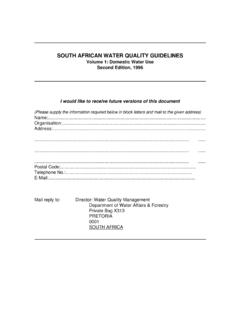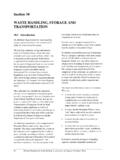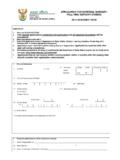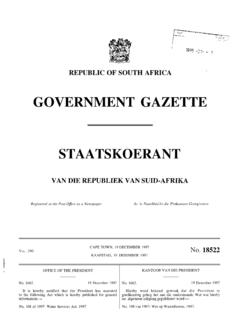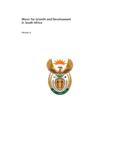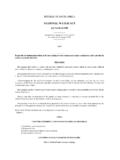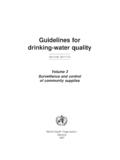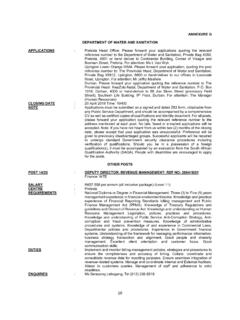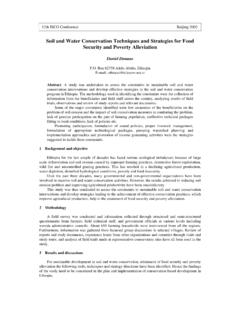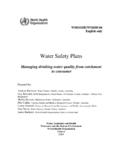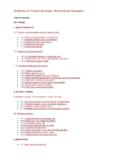Transcription of Layout and design by the Department of Water …
1 Layout and design by the Department of Water Affairs and Forestry Chief Directorate: Communication Services Toll Free Number: 0800 200 200. Best Practice Guideline - G1: Storm Water management -- August 2006. _____. Published by Department of Water Affairs and Forestry Private Bag X313. PRETORIA. 0001. Republic of South Africa Tel: (012) 336-7500. This report should be cited as: Department of Water Affairs and Forestry, 2006. Best Practice Guideline G1 Storm Water management . Copyright reserved Disclaimer: No part of the publication Although the information contained in this document is presented in good faith and may be reproduced in believed to be correct, the Department of Water Affairs and Forestry makes no any manner without representations or warranties as to the completeness or accuracy of the information, full acknowledgement which is only based on actual information received, and makes no commitment to of the source update or correct information.
2 Consultants: Pulles Howard & de Lange Inc. P O Box 861. Auckland park 2006. Republic of South Africa ISBN 0-9585138-0-5. Status Final August 2006. i Best Practice Guideline - G1: Storm Water management -- August 2006. _____. This document is the first in a series of the following general aspects Best Practice Guideline DOCUMENT INDEX documents: BPG G1: Storm Water management BPG G2: Water and Salt Balances BPG G3: Water Monitoring Systems BPG G4: Impact Prediction Authors: ACKOWLEDGE- Mr William Pulles (Pulles Howard & de Lange). MENTS Mr Henry van Rensburg (Pulles Howard & de Lange). Specialists: Ms Blanch Postma (DWAF). Mr Chris Waygood (Jones & Wagener). Mr John Wates (Wates, Meiring & Barnard). Since 1999 a number of steering committee meetings and stakeholder workshops were held at various stages of the development and drafting of this series of Best Practice Guidelines for Water Resource Protection in the South African Mining Industry.
3 We are deeply indebted to the steering committee members, officials of the Department of Water Affairs and Forestry and stakeholders who participated in the meetings and stakeholder workshops held during the development of the series of Best Practice Guidelines for their inputs, comments and kind assistance. The Department would like to acknowledge the authors of this document, as well as the specialists involved in the process of developing this Best Practice Guideline. Without their knowledge and expertise this guideline could not have been completed. ii Best Practice Guideline - G1: Storm Water management -- August 2006. _____. This document is approved by the Department of Water Affairs and APPROVALS. Forestry iii Best Practice Guideline - G1: Storm Water management -- August 2006. _____. Water is typically the prime environmental medium (besides air) that is affected by mining PREFACE activities.
4 Mining adversely affects Water quality and poses a significant risk to South Africa's Water resources. Mining operations can further substantially alter the hydrological and topographical characteristics of the mining areas and subsequently affect the surface runoff, soil moisture, evapo-transpiration and groundwater behaviour. Failure to manage impacts on Water resources (surface and groundwater) in an acceptable manner throughout the life-of- mine and post-closure, on both a local and regional scale, will result in the mining industry finding it increasingly difficult to obtain community and government support for existing and future projects. Consequently, sound management practices to prevent or minimise Water pollution are fundamental for mining operations to be sustainable. Pro-active management of environmental impacts is required from the outset of mining activities.
5 Internationally, principles of sustainable environmental management have developed rapidly in the past few years. Locally the Department of Water Affairs and Forestry (DWAF) and the mining industry have made major strides together in developing principles and approaches for the effective management of Water within the industry. This has largely been achieved through the establishment of joint structures where problems have been discussed and addressed through co-operation. The Bill of Rights in the Constitution of the Republic of South Africa, 1996 (Act 108 of 1996). enshrines the concept of sustainability; specifying rights regarding the environment, Water , access to information and just administrative action. These rights and other requirements are further legislated through the National Water Act (NWA), 1998 (Act 36 of 1998).
6 The latter is the primary statute providing the legal basis for Water management in South Africa and has to ensure ecological integrity, economic growth and social equity when managing and using Water . Use of Water for mining and related activities is also regulated through regulations that were updated after the promulgation of the NWA (Government Notice No. GN704 dated 4 June 1999). The NWA introduced the concept of Integrated Water Resource management (IWRM), comprising all aspects of the Water resource, including Water quality, Water quantity and the aquatic ecosystem quality (quality of the aquatic biota and in-stream and riparian habitat). The IWRM approach provides for both resource directed and source directed measures. Resource directed measures aim to protect and manage the receiving environment. Examples of resource directed actions are the formulation of resource quality objectives and the development of associated strategies to ensure ongoing attainment of these objectives; catchment management strategies and the establishment of catchment management agencies (CMAs) to implement these strategies.
7 On the other hand, source directed measures aim to control the impacts at source through the identification and implementation of pollution prevention, Water reuse and Water treatment mechanisms. The integration of resource and source directed measures forms the basis of the hierarchy of decision-taking aimed at protecting the resource from waste impacts. This hierarchy is based on a precautionary approach and the following order of priority for mine Water and waste management decisions and/or actions is applicable: iv Best Practice Guideline - G1: Storm Water management -- August 2006. _____. RESOURCE PROTECTION AND WASTE described and illustrated in the schematic diagram below. management HIERARCHY. The overall Resource Protection and Waste Step 1: Pollution Prevention management Policy sets out the interpretation of policy and legal principles as well as functional and organisational arrangements for resource protection and Step 2: Minimisation of Impacts waste management in South Africa.
8 Water reuse and reclamation Operational policies describe the rules applicable Water treatment to different categories and aspects relating to waste discharge and disposal activities. Such activities from the mining sector are categorised and classified, based on their potential risks to the Water environment. Step 3: Discharge or disposal of waste and/or waste Water Operational Guidelines contain the requirements for Site specific risk based approach specific documents licence application reports. Polluter pays principle Best Practice Guidelines (BPG's) define and document The documentation describing Water Resource best practices for Water and waste management . Protection and Waste management in South Africa is being developed at a number of different levels, as Schematic Diagram of the Mining Sector Resource Protection and Waste management Strategy v Best Practice Guideline - G1: Storm Water management -- August 2006.
9 _____. The DWAF has developed a series of Best Practice Water use licence applications (and other legally Guidelines (BPGs) for mines in line with International required documents such as EMPs, EIAs, closure Principles and Approaches towards sustainability. The plans, etc.) and for drafting licence conditions. series of BPGs have been grouped as outlined below: Serve as a uniform basis for negotiations through the licensing process prescribed by the NWA. BEST PRACTICE GUIDELINES dealing with aspects of DWAF's Water management HIERARCHY are prefaced Used specifically by DWAF personnel as a basis for with the letter H. The topics that are covered in these negotiation with the mining industry, and likewise by guidelines include: the mining industry as a guideline as to what the DWAF. considers as best practice in resource protection and H1.
10 Integrated Mine Water management waste management . H2. Pollution Prevention and Minimisation of Impacts Inform Interested and Affected Parties on good H3. Water Reuse And Reclamation practice at mines. H4. Water Treatment The information contained in the BPGs will be transferred BEST PRACTICE GUIDELINES dealing with GENERAL through a structured knowledge transfer process, which Water management strategies, techniques and tools, includes the following steps: which could be applied cross-sectoral and always Workshops in key mining regions open to all interested prefaced by the letter G. The topics that are covered in parties, including representatives from the mining these guidelines include: industry, government and the public. G1. Storm Water management Provision of material to mining industry training G2. Water and Salt Balances groups for inclusion into standard employee training programmes.
